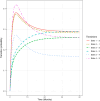Utilizing a multi-stage transition model for analysing child stunting in two urban slum settlements of Nairobi: A longitudinal analysis, 2011-2014
- PMID: 38408049
- PMCID: PMC10896550
- DOI: 10.1371/journal.pone.0272684
Utilizing a multi-stage transition model for analysing child stunting in two urban slum settlements of Nairobi: A longitudinal analysis, 2011-2014
Abstract
Introduction: Stunting is common among children in many low and middle income countries, particularly in rural and urban slum settings. Few studies have described child stunting transitions and the associated factors in urban slum settlements. We describe transitions between stunting states and associated factors among children living in Nairobi slum settlements.
Methods: This study used data collected between 2010 and 2014 from the Nairobi Urban and Demographic Surveillance System (NUHDSS) and a vaccination study nested within the surveillance system. A subset of 692 children aged 0 to 3 years, with complete anthropometric data, and household socio-demographic data was used for the analysis. Height-for-age Z-scores (HAZ) was used to define stunting: normal (HAZ ≥ 1), marginally stunted (-2 ≤ HAZ < -1), moderately stunted (-3 ≤ HAZ < -2), and severely stunted (HAZ < -3). Transitions from one stunting level to another and in the reverse direction were computed. The associations between explanatory factors and the transitions between four child stunting states were modeled using a continuous-time multi-state model.
Results: We observed that 48%, 39%, 41%, and 52% of children remained in the normal, marginally stunted, moderately stunted, and severely stunted states, respectively. About 29% transitioned from normal to marginally stunted state, 15% to the moderately stunted state, and 8% to the severely stunted state. Also, 8%, 12%, and 29% back transitioned from severely stunted, moderately stunted, and marginally stunted states, to the normal state, respectively. The shared common factors associated with all transitions to a more severe state include: male gender, ethnicity (only for mild and severe transition states), child's age, and household food insecurity. In Korogocho, children whose parents were married and those whose mothers had attained primary or post-primary education were associated with a transition from a mild state into a moderately stunted state. Children who were breastfed exclusively were less likely to transition from moderate to severe stunting state.
Conclusion: These findings reveal a high burden of stunting and transitions in urban slums. Context-specific interventions targeting the groups of children identified by the socio-demographic factors are needed. Improving food security and exclusive breastfeeding could potentially reduce stunting in the slums.
Copyright: © 2024 Oduro et al. This is an open access article distributed under the terms of the Creative Commons Attribution License, which permits unrestricted use, distribution, and reproduction in any medium, provided the original author and source are credited.
Conflict of interest statement
The authors have declared that no competing interests exist.
Figures



Similar articles
-
Factors associated with recovery from stunting among under-five children in two Nairobi informal settlements.PLoS One. 2019 Apr 18;14(4):e0215488. doi: 10.1371/journal.pone.0215488. eCollection 2019. PLoS One. 2019. PMID: 30998790 Free PMC article. Clinical Trial.
-
Household food (in)security and nutritional status of urban poor children aged 6 to 23 months in Kenya.BMC Public Health. 2015 Oct 13;15:1052. doi: 10.1186/s12889-015-2403-0. BMC Public Health. 2015. PMID: 26463345 Free PMC article.
-
Effect of mother's education on child's nutritional status in the slums of Nairobi.BMC Pediatr. 2012 Jun 21;12:80. doi: 10.1186/1471-2431-12-80. BMC Pediatr. 2012. PMID: 22721431 Free PMC article.
-
Nutritional interventions for preventing stunting in children (birth to 59 months) living in urban slums in low- and middle-income countries (LMIC).Cochrane Database Syst Rev. 2019 Jun 17;6(6):CD011695. doi: 10.1002/14651858.CD011695.pub2. Cochrane Database Syst Rev. 2019. PMID: 31204795 Free PMC article.
-
The history, geography, and sociology of slums and the health problems of people who live in slums.Lancet. 2017 Feb 4;389(10068):547-558. doi: 10.1016/S0140-6736(16)31650-6. Epub 2016 Oct 16. Lancet. 2017. PMID: 27760703 Review.
Cited by
-
Association between household food insecurity and stunting in children aged 0-59 months: Systematic review and meta-analysis of cohort studies.Matern Child Nutr. 2024 Apr;20(2):e13609. doi: 10.1111/mcn.13609. Epub 2024 Jan 9. Matern Child Nutr. 2024. PMID: 38196291 Free PMC article.
-
Forecasting progress: analyzing the trajectory of under-five child mortality for Ghana, Niger, Nigeria, and Sierra Leone towards SDG3 using ARIMA time series model.BMC Public Health. 2025 May 1;25(1):1607. doi: 10.1186/s12889-025-22869-z. BMC Public Health. 2025. PMID: 40312307 Free PMC article.
References
-
- World Health Organization. Levels and trends in child malnutrition: key findings of the 2018 edition. World Health Organization; 2018.
-
- World Health Organization. Nutrition in universal health coverage. World Health Organization; 2019.
MeSH terms
LinkOut - more resources
Full Text Sources
Medical

